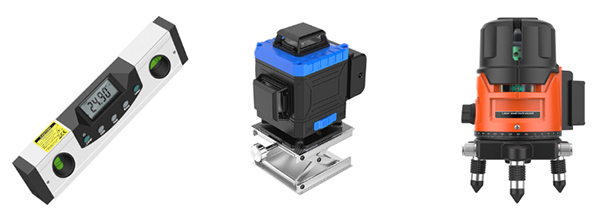The laser level is mainly used to measure the height difference of the ground benchmarking point. The laser level's working principle is to set a horizontal plane and scan the laser on this horizontal plane, and then use the receiving target to receive it. When the center of the receiving target is consistent with the elevation, it can be read according to this level. Out of the elevation; therefore, the laser level can be operated by one person. In the construction industry, the spirit level is an indispensable measuring tool, which can measure the horizontal position, vertical position, and inclination angle of equipment installation. So do you know how to choose a laser level?
In fact, the light of the level is one of the most critical factors. In addition to the red and green light colors, the number of laser lines will also lead to differences in the scope of use of the level. SISCO will introduce in detail the key points of choosing a laser level so that you can choose with confidence.

Which kind of light is better for the level meter?
The brightness of the green light level meter is stronger and clearer, the construction is less affected by the environment and the construction range is wider, so for the specialized construction team, the practicality of the green light level meter is higher. The red light level meter is a little weaker, plus the price is affordable and more suitable for use in indoor simple home decoration.
How to choose the line number of the level meter?
The number of lines at the level refers to the number of laser beams produced by the level. The more laser beams, the construction time can be shortened and the construction accuracy can be increased. The common ones are 2-wire, 3-wire, and 5-wire level gauges. With different numbers of lines, the laser lines that can be emitted are different, and the corresponding range of use is also different.
- 2-line laser level: One horizontal line, one vertical line. It can measure horizontal and plumb lines, suitable for simple home use such as wall tiles.
- 3-line laser level: one horizontal line, two vertical lines. It can measure horizontal and plumb lines, and can also measure right angles in one direction and vertical points in space on the ground or zenith, suitable for home decoration.
- 5-line laser level: one horizontal line, four vertical lines. It can measure horizontal and plumb lines, and can also measure four-direction right angles and vertical points in space on the ground or zenith. It has a wider range of measurement accuracy and is suitable for outdoor engineering use.
Tips for choosing a right laser level
- Look at the appearance of the level: When purchasing a level, the first thing to do is to observe the appearance, whether the scale is obvious and clear, whether the surface is smooth and free of scratches, pores, rust, etc. In addition, the scale line of the level should also be consistent with the level. The axes are perpendicular, otherwise, it will not only affect its beauty but also affect the accuracy of our measurement data.
- Check the accuracy of the laser level: Before the test, all parts of the level must be cleaned, and then the level should be placed on the metal plate in the test room, and the same temperature time should not be less than 3 hours. The temperature in the inspection room should be 20±2°C, and the inspection should be carried out under the condition of firmness, no vibration, and away from heat sources.
- Look at the structure of the level: the firmness of the structure of the level determines whether the laser level is easy to be damaged during storage and use, even after it is dropped to the ground, and whether it will affect the overall frame structure, otherwise, it will be broken within a few days after buying it back, or it will be damaged. Often take it for calibration, the gain outweighs the gain.
- Look at the material of the level: on the one hand, the quality of the level material will affect its durability, and on the other hand, it has a lot to do with its accuracy. At present, the more common materials on the market are steel, cast iron, and magnesium-aluminum alloys. Among them, magnesium-aluminum alloys are more durable and have better resistance to bending and deformation. Therefore, it is recommended to choose magnesium-aluminum alloys first.

